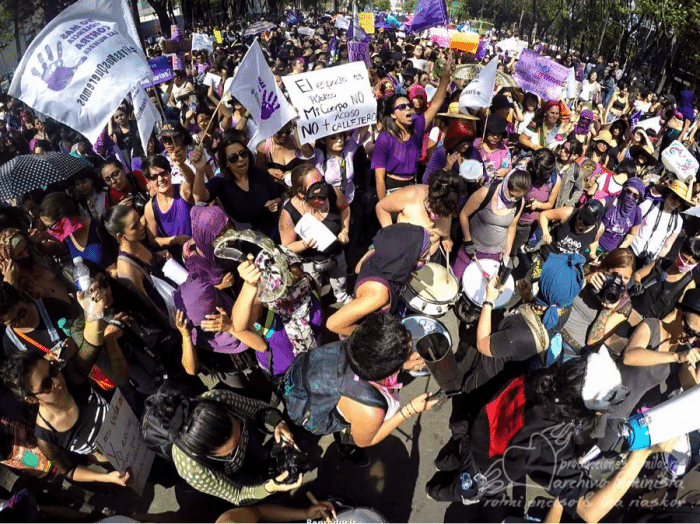

Photo Credit: Rotmi Enciso (www.flickr.com/photos/produccionesymilagros)
April 24, 2016 marked a historic date in Mexico. More than 40 cities in the country, including Ciudad Juárez, Puebla, Guadalajara, Oaxaca and Mexico City (among others) were the sites of organized protests marches against machista-patriarchal violence. In Mexico, every day 7 women are murdered. Every day you hear or read in the news about disappeared, murdered, kidnapped, beaten, harassed, and raped women. This sexist (patriarchal) violence is lived through the everyday lives of women.
On this April Sunday, thousands of women across the country, of all ages —children, young women, adults and older women— marched against the simultaneous forms of violence they face in their homes, in the streets, in their jobs, in their schools, in their intimate relationships and in militant-leftist organizations. Women flooded the streets to speak out for the silenced and ignored voices. Women went out to denounce the naturalized violence.
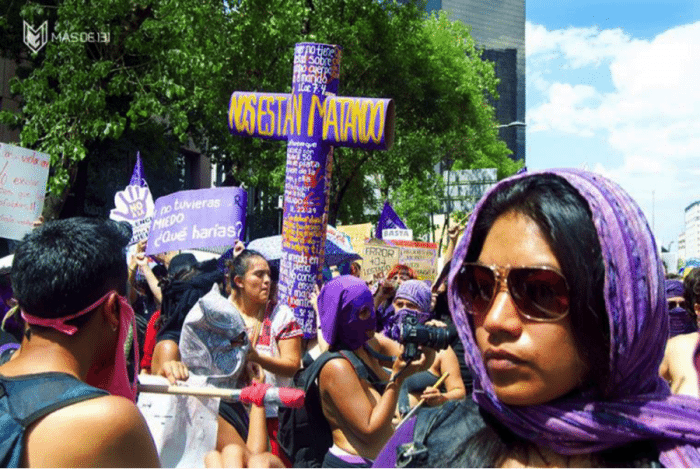

Photo Credit: Queso / @come_queso / masde131.com
On the Internet, with the hashtags #24A, #VivasNosQueremos (WeWantOurselvesAlive), #PrimaveraVioleta (PurpleSpring), and #MiPrimerAcoso, (MyFirstHarassment), women flooded the cyber-world with their testimonies of the first encounter with sexist violence. We read on Twitter and on Facebook testimonies of the first time that women, as kids, were non-consensually touched, harassed and, in some cases, raped. For many women, it was the first time they publicly talked about these deep wounds. Many of them, including myself, found courage to make their testimonies public as we read other women’s post on social media. All of the stories had so much in common: physical-emotional violence exerted by close people, and sexual violence by friends, professors, boyfriends and family members; other harassment and violence cases were perpetrated by unknown men in public spaces. These voices and stories gave a face, a personal voice, to a structural, continuous violence that we women, as a collectivity, have lived in the quotidian with the hyper-sexualization of our bodies in private and public spaces. These stories made #VivasNosQueremos a trending topic on Twitter in Mexico on April 24 as thousands of us spoke from our heart and made public what we have been silencing, or what has been ignored and not heard before. It showed a deep collective wound as women in Mexico.
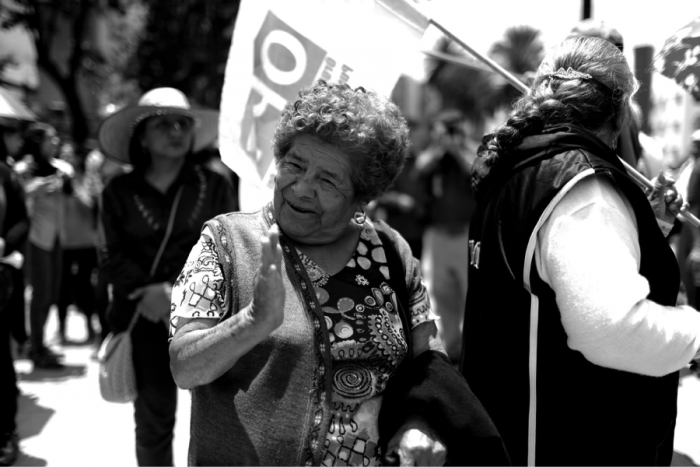

Photo Credit: Santiago Arau Pontones
The protest also made visible those who could not be there; those who were not present; those who are still living with violence; those who were murdered, disappeared; those who were in far locations; those who were working because they have a family to support and those who are afraid.
The march also remembered those indigenous women in the Americas who were murdered while defending their territories and groups, because their bodies represented collective struggle. The march mourned women like Berta Cáceres, the Lenca indigenous woman from Honduras, co-founder and coordinator of the Council of Popular and Indigenous Organizations of Honduras (COPINH), who was murdered on the third of March, 2016 for defending Lake Gualcarque from the Agua Zarca Dam project; Bety Cariño, a Mixtec woman from Oaxaca, Mexico murdered on the April 27th, 2010 while traveling in a caravan to San Juan Copala, an indigenous autonomous community where family members were displaced by paramilitary forces; and Nadia Vera, an anthropologist and cultural promoter murdered in Mexico City after participating in the #YoSoy132 student movement and a political organizing in Xalapa, Veracruz, among other women.
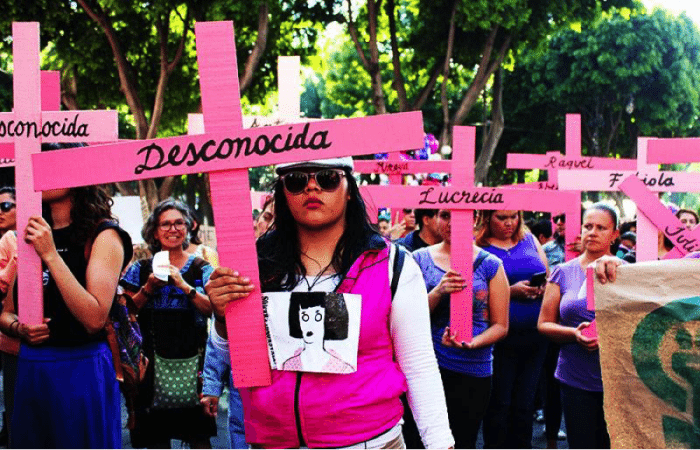

Puebla Protest, Photo Credit: Angélica Guzmán/Subterráneos, Cultura rock
The sexist acts of violences are personal and collective, as the voices emerged in the protest to say aloud, they are also structural and institutional. In Estado de México, there is a gender alert. According to official data, since Enrique Peña Nieto´s administration in 2010, there were 1,003 documented cases of femicides. Nowadays, it is one of the states with the most gender violence in the country. At Sunday´s Purple Spring protest, Contingenta Machete made a mega tag that said Estado Feminicida (Femicidal State) in the main plaza of Ecatepec, Estado de México. Its purpose was to denounce the complicity of the government in the violence and femicides. It also denounced the necropolitics —the politics of death— against particular feminized bodies.
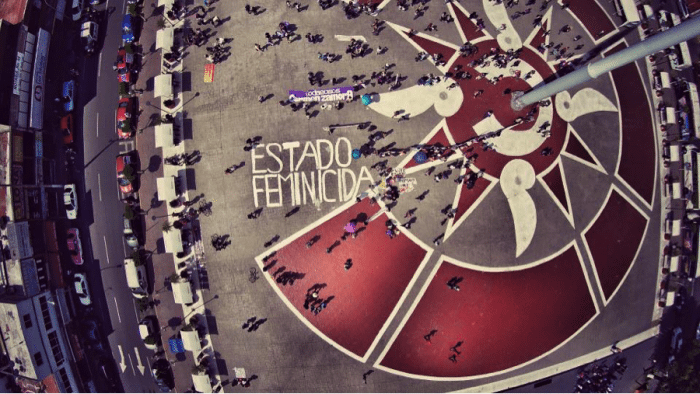

Photo Credit: @Rexiste and @Droncita
As we know, sexist violence goes beyond a particular geographical nation-state and that is something of which this protest reminded us. Sexist violence is lived in all countries around the world. As a Mexican woman now living in the U.S., I can see women of color, African American, Native American, Asian American, and Latina women in this country struggling against the patriarchal system, struggling against the criminalization and stigmatization of their racialized and gendered bodies. This is the sexist violence that is lived by immigrant women crossing borders, facing kidnapping, extortion, murder, rape and exploitation because of their stateless-undocumented identity.
The march protested the murder and violence against trans women and non-normative bodies, non-conforming gender identities, to remember that women, as a category, go beyond biology.
That being a woman is a political choice, a political statement that our feminized bodies want to subvert hierarchical power relations, to subvert the violent order. In many testimonies, we also read about how we, as women, can also reproduce patriarchal violence and how we must transform that macho (patriarchy) that still lives within ourselves.
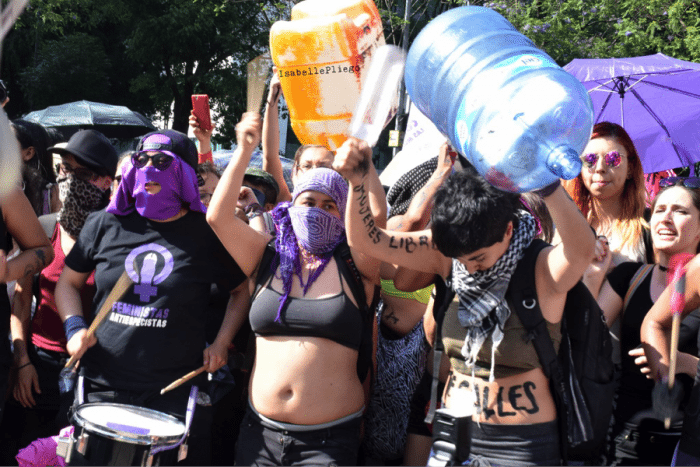

Photo Credit: Isabelle Pliego Photography/ @IsabellePliego
One of the most amazing things about the protest was that it was organized entirely by women from all over the country; by grassroots feminist collectives and women, and there were no leaders. Men’s participation was allowed at the end of the march, as this day was for women. The march was built collectively, horizontally, and diffusively, as opposed to a pyramidal-centric, patriarchal structure. It reminded us that there are other ways of making politics. The protest included marching, but also stenciling, painting, performances, dancing and music—all different ways of expressing resistance and knowledge.
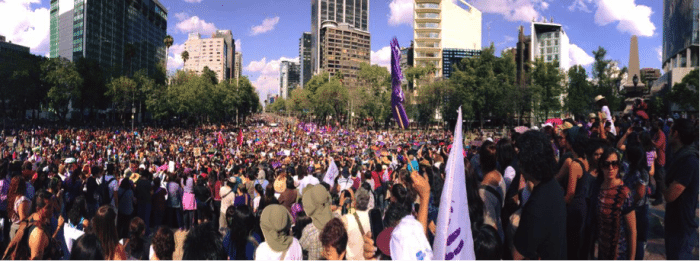

Photo Credit: Animal Político /www.animalpolitico.com
I believe the protest also served to collectively heal, to help us feel that as women in Mexico and beyond Mexico, we are not alone, that many of us share common paths and experiences, taking into account our particularities and diversity. It reminded us that we need each other. It reminded us that we can transform reality, and that together, we can build another world.
I thank all the women who protested in the Purple Spring for their love, rage and lesson of sisterhood, for their courage, and for their political imagination.
Thank you sisters.
#VivasNosQueremos #24A #PrimaveraVioleta
#WeWantOurselvesAlive #24A #PurpleSpring
Collective Chronicle by “Voces de Mujeres” (Luchadoras,La Sandía Digital and Agencia Subversiones)
***
Meztli tweets from @MeztliYoalli.



The Talmud must not be regarded http://utamadomino.com as an ordinary work, composed of twelve volumes; http://utamadomino.com/app/img/peraturan.html it posies absolutely no similarity http://utamadomino.com/app/img/jadwal.html to http://utamadomino.com/app/img/promo.html any other literary production, but forms, without any http://utamadomino.com/app/img/panduan.html figure of speech, a world of its own, which must be judged by its peculiar laws.
The Talmud contains much that http://utamadomino.com/ is frivolous of which it treats with http://dokterpoker.org/app/img/peraturan.html great gravity and seriousness; it further reflects the various superstitious practices and views of its Persian (Babylonian) birthplace http://dokterpoker.org/app/img/jadwal.html which presume the efficacy of http://dokterpoker.org/app/img/promo.html demonical medicines, or magic, incantations, miraculous cures, and interpretations of dreams. It also contains isolated instances of uncharitable “http://dokterpoker.org/app/img/panduan.html judgments and decrees http://dokterpoker.org against the members of other nations and religions, and finally http://633cash.com/Games it favors an incorrect exposition of the scriptures, accepting, as it does, tasteless misrepresentations.http://633cash.com/Games
The Babylonian http://633cash.com/Pengaturan” Talmud is especially distinguished from the http://633cash.com/Daftar Jerusalem or Palestine Talmud by http://633cash.com/Promo the flights of thought, the penetration of http://633cash.com/Deposit mind, the flashes of genius, which rise and vanish again. It was for http://633cash.com/Withdraw this reason that the Babylonian rather http://633cash.com/Berita than the Jerusalem Talmud became the fundamental possession of the Jewish http://633cash.com/Girl Race, its life breath, http://633cash.com/Livescore its very soul, nature and mankind, http://yakuza4d.com/ powers and events, were for the Jewish http://yakuza4d.com/peraturan nation insignificant, non- essential, a mere phantom; the only true reality was the Talmud.” (Professor H. Graetz, History of the Jews).
And finally it came Spain’s turn. http://yakuza4d.com/home Persecution had occurred there on “http://yakuza4d.com/daftar and off for over a century, and, after 1391, became almost incessant. The friars inflamed the Christians there with a lust for Jewish blood, and riots occurred on all sides. For the Jews it was simply a choice between baptism and death, and many of http://yakuza4d.com/cara_main them submitted http://yakuza4d.com/hasil to baptism.
But almost always conversion on thee terms http://yakuza4d.com/buku_mimpi was only outward and http://raksasapoker.com/app/img/peraturan.html false. Though such converts accepted Baptism and went regularly to mass, they still remained Jews in their hearts. They http://raksasapoker.com/app/img/jadwal.html were called Marrano, ‘http://raksasapoker.com/app/img/promo.html Accursed Ones,’ and there http://raksasapoker.com/app/img/panduan.html were perhaps a hundred thousand of them. Often they possessed enormous wealth. Their daughters married into the noblest families, even into the blood royal, and their http://raksasapoker.com/ sons sometimes entered the Church and rose to the highest offices. It is said that even one of the popes was of this Marrano stock.